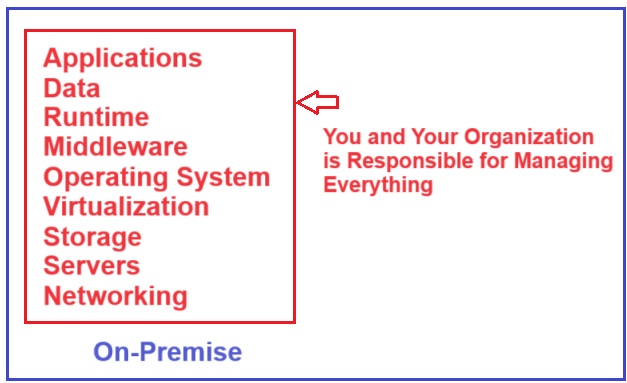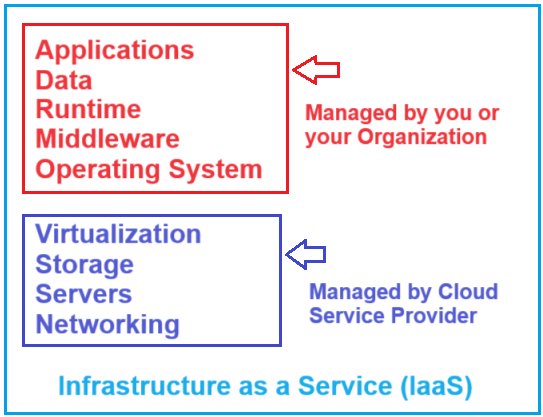Back to: Cloud Computing Tutorials for Beginners and Professionals
Infrastructure as a Service (IaaS) in Cloud Computing
In this article, I will discuss Infrastructure as a Service, also called IaaS, in Cloud Computing. Please read our previous article discussing the Different Types of Services in Cloud Computing. At the end of this article, you will understand Infrastructure as a Service (IaaS) in Cloud Computing. Who uses this service, and what are the advantages it provides?
How do we Manage an On-Premise Data Center or Server?
Managing an on-premises data center or server involves various tasks. Let us understand how we manage the infrastructure, i.e., an on-premise data center, if we are not using cloud services. Without cloud services, we need to manage everything on-premise. The organization is only responsible for doing everything or managing everything as follows.
- Purchasing Physical Servers, Storage, and related hardware
- Install and set up the network
- Setting up the server room or data center
- Ensure the main power supply, backup power supply, cooling system, etc, are in place.
- Install and configure virtualization software, operating system, runtime components, etc.
- Install, configure, and manage your custom or packaged apps and data.
So, your organization is only responsible for managing everything without the cloud. For a better understanding, please have a look at the below image.

Let us understand the above terms in detail:
- Applications: Applications refer to software programs or services that users access over the internet. These can range from simple web applications to complex enterprise software.
- Data: Data refers to information that can be processed, stored, or transmitted by computer systems. This includes databases, files, documents, or any digital information.
- Runtime: Runtime refers to the execution environment where applications run. It includes the environment, resources, and services required for the application to operate correctly.
- Middleware: Middleware refers to the software that connects different applications or services. It acts as a bridge between various components of an application stack, enabling communication and integration. Middleware can include services like message queues, application servers, database management systems (DBMS), etc.
- Operating System: The operating system (OS) is the software that manages hardware resources and provides common services for computer programs. It acts as an intermediary between applications and hardware, handling tasks such as memory management, process scheduling, file management, and user interface interactions.
- Virtualization: Virtualization refers to the creation of virtual versions of hardware, operating systems, storage devices, or network resources. It enables multiple virtual instances (such as virtual machines or containers) to run simultaneously on a single physical machine, optimizing resource utilization, scalability, and flexibility.
- Storage: Storage refers to the physical or virtual devices and systems used to store and retain data persistently. It includes hard disk drives (HDDs), solid-state drives (SSDs), and other storage devices. Storage systems provide data accessibility, durability, and reliability for applications and users.
- Servers: Servers are physical or virtual machines that host applications, services, or data. Servers often host and deliver applications, manage data storage, or provide access to shared resources and services over a network.
- Networking: Networking involves the systems, protocols, and infrastructure used to establish communication and connectivity between computers, devices, or systems within a network. It enables data exchange, resource sharing, and collaboration between users and applications across local and wide area networks (LANs/WANs).
It’s important to note that managing an on-premises data center requires a significant investment of time, resources, and expertise. Many organizations opt for cloud computing solutions (such as IaaS, PaaS, or SaaS) to offload some of these responsibilities and benefit from cloud provider services. Now, let us proceed and understand what Infrastructure as a Service is and what it provides in cloud computing.
What is Infrastructure as a Service (IaaS) in Cloud Computing?
Infrastructure as a Service (IaaS) in cloud computing refers to a model where cloud providers like Microsoft Azure, Amazon Web Services, or others offer virtualized computing resources over the Internet. In the Infrastructure as a Service (IaaS) model, users can rent and manage virtual machines (VMs), storage, networking, servers, and other computing resources on a pay-as-you-go basis. To understand this better, please have a look at the following diagram.

As the name implies, with Infrastructure as a Service (IaaS), the cloud service provider provides the infrastructure over an internet connection or through a Virtual Private Network. In our upcoming articles, we will discuss what a Virtual Private Network is. For now, you can think of it as a dedicated and secure private channel between you (i.e., your organization) and the cloud service provider.
So the important point to keep in mind here is that there is no need for your organization to purchase and manage the infrastructure. It is the cloud service provider that is responsible for
- Providing Physical Servers, Storage, and related hardware
- Install and set up the network
- Ensure a proper power supply, backup power supply, cooling system, etc., is in place.
- The cloud service provider is also responsible for setting up, securing, and managing the cloud data center.
In simple terms, this is how it works: The cloud service provider hosts the infrastructure at its data center. As a customer, you use this infrastructure on-demand over the Internet or through a virtual private connection, and you pay a fee for the duration of your use of the infrastructure. You are only charged based on the number of machines and resources used.
As you can see from the image, the cloud service provider manages networking, storage, servers, and virtualization. However, you are still responsible for the rest (OS, Middleware, Runtime, Data, and Application).
This means. now you have better control, and you can install any operating system of your choice, such as Windows or Linux. So the point is, you can use this infrastructure for anything you want. For example, you may have a web application you want to host and run. You can also use it for your storage needs. For example, install SQL Server, Oracle, or other relational databases and store your business data. Infrastructure as a service (IaaS) is also known as Hardware as a service (HaaS).
Who Uses Infrastructure as a Service (IaaS)?
In most organizations, it is the Infrastructure team (Infra Team), that manages the servers and computers. Install the software and provide systems to employees. Set up and manage networks. So in most cases, it is usually your infrastructure team that uses Infrastructure as a Service (IaaS). Sometimes, even software development teams use this service if they want to have enhanced control over the underlying hardware and network.
Common Use Cases of Infrastructure as a Service (IaaS):
- Web Hosting: Hosting websites on virtual servers that are scalable with changing demand.
- Storage, Backup, and Recovery: Managing data with scalable options and without the physical limitations of onsite hardware.
- Web Apps: Hosting, developing, and maintaining web applications with the ability to scale infrastructure as traffic grows.
- High-Performance Computing: Using complex and high-performance computations such as scientific simulations, financial modeling, and real-time data processing.
Benefits of Infrastructure as a Service (IaaS)
The following are the Benefits of using Infrastructure as a Service (IaaS) in Cloud Computing:
Reduced Financial Risk
There is a reduced financial risk for organizations. Let’s say, for example, you want to try something new (maybe you are launching a new business or product or experimenting with something entirely new). To do this, you need a software application. To host and run the application, you need a server, all the related infrastructure, and a workforce team to set up and maintain the server. What if your new product launch or experiment fails? You have already spent a huge amount of capital to purchase the server and related infrastructure.
With Infrastructure as a Service (IaaS), you pay a fee to the cloud service provider as long as you use the cloud infrastructure. In the Cloud, you host your app and run it from there. If your new product launch or experiment succeeds, well and good. If it doesn’t shut things down and you pay no longer. You can see how organizations can benefit from reduced financial risk straight away. This encourages businesses to try new things, experiment, and innovate more.
Deployment Speed:
Just imagine the time to set up the physical servers, storage, and related infrastructure. You need to purchase the required computer and hardware. Get them shipped to your organization. Create a server room or data center. Secure it. Install power supply and cooling systems. Setup and configure network. The list goes on. You also need to hire skilled people to do all these. It takes a considerable amount of time to have all these in place. Probably days, sometimes even months in worst-case scenarios.
On the other hand, if you use Infrastructure as a Service (IaaS) from your web browser, with a few clicks, you have one or many virtual machines procured from the cloud service provider in just a few minutes. This shows the speed with which you can set up and start using cloud infrastructure, so you have time to focus on what matters to your business.
Provision resources from geographically closer locations
Cloud service providers like Amazon, Microsoft, and Google have data centers worldwide. This means that with the Infrastructure as a Service, you have the option of provisioning the servers from geographic locations close to your customers.
Unlimited Scalability
A public cloud provides near-unlimited scalability, and you will almost never run out of resources. You can set threshold limits to scale up and down depending on demand automatically.
Security:
IaaS providers typically offer robust security measures to protect data and infrastructure. Security features may include data encryption, identity and access management (IAM), firewalls, and compliance certifications.
Pay-as-You-Go Pricing:
IaaS follows a utility computing model in which users pay only for the resources they use. This cost-effective approach eliminates the need for upfront hardware investments and reduces operational expenses related to maintenance and management.
Popular IaaS Providers:
- Amazon Web Services (AWS): Offers a wide range of IaaS services under its EC2 (Elastic Compute Cloud), S3 (Simple Storage Service), and VPC (Virtual Private Cloud) offerings.
- Microsoft Azure: This provider provides IaaS capabilities through Azure Virtual Machines, Azure Storage, and Azure Virtual Network, among other things.
- Google Cloud Platform (GCP): Offers IaaS services like Compute Engine for VMs, Cloud Storage for scalable storage solutions, and Virtual Private Cloud (VPC) for networking.
IaaS provides the flexibility and scalability needed for businesses to run applications without the overhead of managing physical hardware. IaaS allows organizations to build, manage, and scale their IT infrastructure efficiently and cost-effectively.
In the next article, I am going to discuss Platform as a Service, also called PaaS, in Cloud Computing. In this article, I explain Infrastructure as a Service (IaaS) in Cloud Computing. I hope you understand the need and use of Infrastructure as a Service (IaaS) in Cloud Computing.


I Love this website and I always Read articles daily,
It’s Enjoyable for me,
because you provide info in a simple way and It’s so easy to understanding for beginners and professionals,
Really I am thankful to you